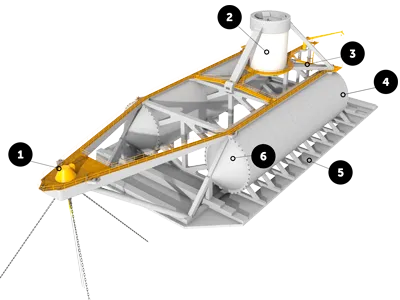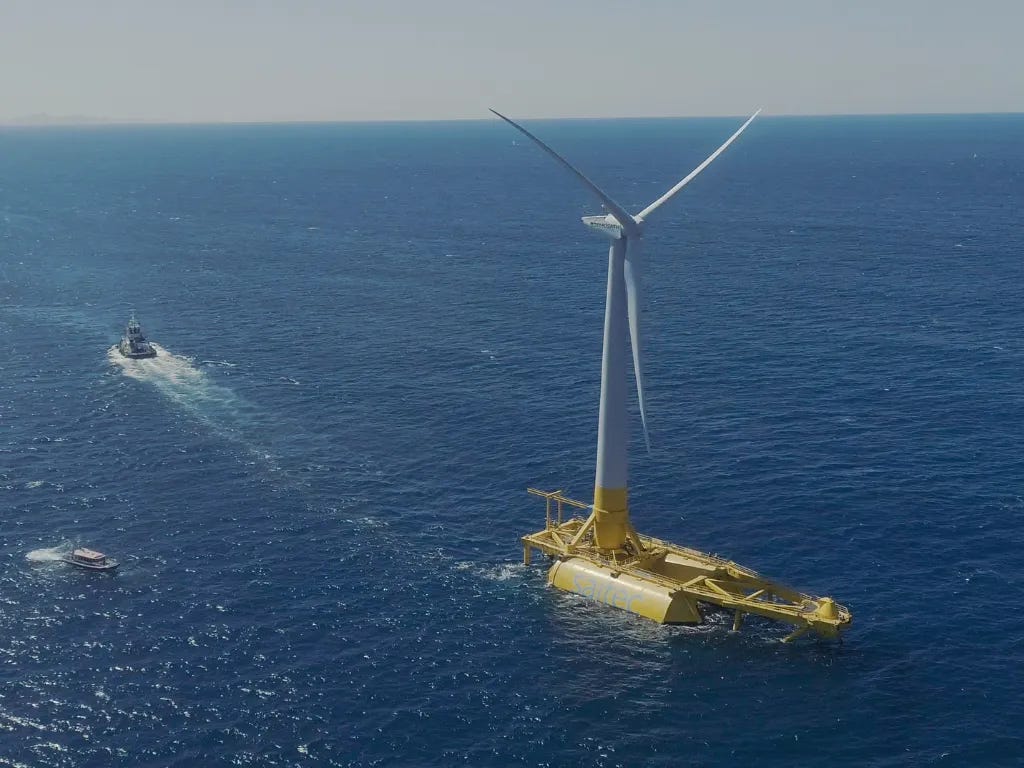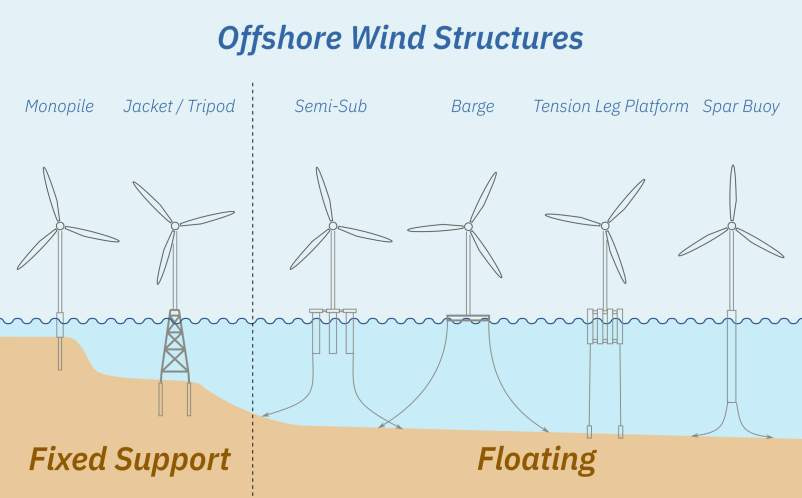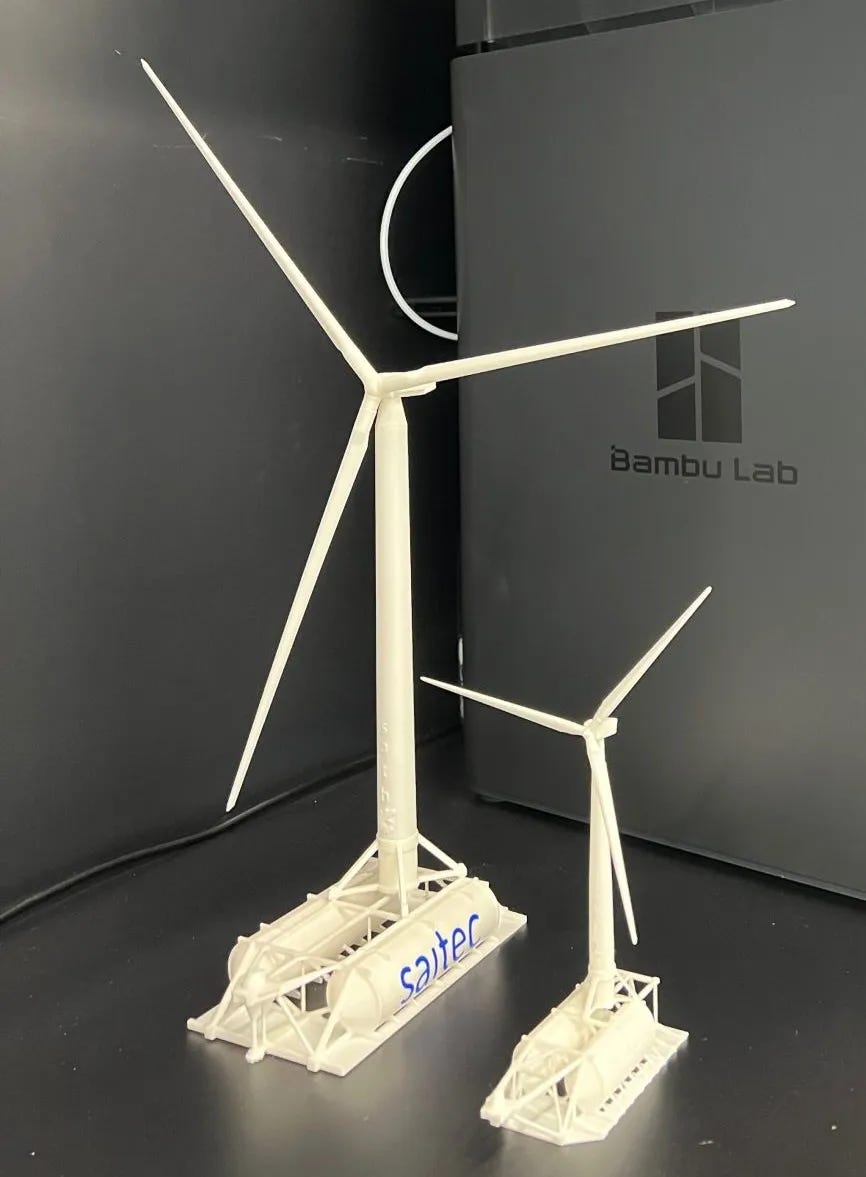Windstory #10 - The floating prototype by Saitec Offshore Technologies celebrates one year: here are the conclusions
After one year of operation of the DemoSATH, we reached out to Saitec Offshore Technologies to share firsthand conclusions
Hello everyone and welcome to a new issue of Windletter. I'm Sergio Fernández Munguía (@Sergio_FerMun) and here we discuss the latest news in the wind power sector from a different perspective. If you enjoy the newsletter and are not subscribed, you can do so here.
Windletter is sponsored by:
🔹 Tetrace. Specialized services in operation and maintenance, engineering, supervision, inspection, technical assistance, and distribution of spare parts in the wind sector. More information here.
🔹 RenerCycle. Development and commercialization of solutions and specialized services in the circular economy for renewable energies, including comprehensive dismantling of wind farms and waste management, refurbishment and sale of components and wind turbines, management and recycling of blades and others. More information here.
Windletter está disponible en español aquí
Windstory is the article section of Windletter. It’s a section where we share curious and interesting stories from the wind sector. Occasionally, with no set schedule, a Windstory edition will arrive in your inbox.
The DemoSATH of Saitec Offshore Technologies turns one
It has been more than a year since Saitec Offshore Technologies launched its floating wind turbine prototype (DemoSATH) at the BIMEP testing center on the coast of Bizkaia. And nearly two and a half years since I had the opportunity to visit it at the port of Bilbao, which we covered in edition #12 of Windletter. A lot has happened since then.
After a year in operation, Saitec Offshore Technologies has drawn several conclusions and gathered data, so we contacted them (thank you very much, David Carrascosa, for your willingness) to get first-hand details.
Let’s start from the beginning.
The origins
Saitec Offshore Technologies is a spin-off of the Saitec Group, a Spanish engineering company specializing in infrastructure projects around the world. The offshore subsidiary was born from Saitec’s R&D department, where the SATH (Swinging Around Twin Hull) floating platform technology was patented.
The SATH platform is a barge-type platform, and one of its main differentiations is that it is made of concrete, which facilitates job creation and local content in the places where it will be manufactured.
The first milestone of this project was the BlueSATH prototype, a 1:6 scale version that housed a 30 kW wind turbine with a 15-meter rotor diameter. It was installed in the Abra del Sardinero (Santander) in 2020.
Construction and Launch of the DemoSATH
After the experience with the BlueSATH, it was decided to take the next step, which can be considered full scale, with the construction of the DemoSATH. This time, the platform houses a 2 MW wind turbine (specifically a Senvion MM82), which tests the platform in real conditions and can be seen as a precursor to a hypothetical commercial version of >10 MW.
The construction of this prototype took place at the port of Bilbao and is well documented on Saitec Offshore’s YouTube channel. It even has a dedicated program on “Mega Structures at Sea” on DMAX, which is definitely worth watching.
Transporting and anchoring the DemoSATH at its final location was not without challenges, with several failed attempts to secure the platform to the seabed. This was somewhat expected considering that we are talking about a unique prototype.
It was not until September 2023 that the DemoSATH was connected to the grid, marking several milestones:
The first floating wind turbine in Spain to connect to the electrical grid.
The fifth European floating technology with a turbine of over 1 MW installed in open sea.
The third concrete-based technology to reach this level of development. Other concrete platforms that have prototypes or operational full-scale parks are the Hywind Tampen spar and BW Ideol's barge.
The prototype is located in an area with a depth of 85 meters in the Cantabrian Sea, 2 nautical miles from the coast, in the municipality of Armintza. The anchoring system consists of six hybrid lines (composed of chains and fiber).
Conclusions and data after a year of operation
A few weeks ago, the DemoSATH celebrated its one-year operation, an occasion that the project partners did not want to miss to celebrate on social media, with reactions from the German RWE, the Japanese Kansai Electric Power (KEPCO), and Saitec itself.
After a year in operation, Saitec Offshore and its partners have been able to gather valuable information about the prototype and its potential as a commercial solution.
According to Saitec, the platform has demonstrated “exceptional resilience and reliability in extreme marine environments,” consistently withstanding extreme maritime conditions, with “waves of up to 10.78 meters (recorded on November 4, 2023) and wind gusts of up to 100 km/h.”
The double-hull design of the platform (the two cylindrical floats), connected to the damping plate and the turret-type anchoring system (inherited from the Oil & Gas industry) “have proven effective in enhancing stability, significantly reducing the impact of large waves and strong winds.”

And the numbers back it up: 98% of the time, the maximum pitch and roll movement amplitude (i.e., the pitching and rolling of the assembly) has remained below 2.5º relative to the waterline. A value that has not been exceeded either in operational phases or when the turbine has been stopped.
This is all considering that its location (the coast of Bizkaia) is particularly challenging, where wave heights exceed 1.5 meters 42% of the time. Meanwhile, in the North Sea, “this limit of 1.5 meters significant wave height is exceeded 30% of the time on average, 10% less compared to the BIMEP site where DemoSATH is deployed.”
Additionally, Saitec informs us that during this year, the turbine has not had to stop its operation for any platform-related reasons: “Whenever it has halted operation, it has been because the wind has exceeded 25 m/s, just as it would on land, and never due to wave conditions.”
One of the main objectives of any floating platform is that its dynamic behavior does not affect the operation of the wind turbine, meaning it should not go into emergency mode due to excessive rolling or vibrations. This is only achieved if the platform is stable enough.
In principle, the DemoSATH will remain at BIMEP for at least 2 years, so we are currently at the midpoint of the tests.
Certification from Bureau Veritas and next steps
The DemoSATH reached an important milestone on September 26, 2024, when it obtained Final Prototype Certification from Bureau Veritas.
This certification is the result of a thorough review of over 400 documents and a detailed assessment of various engineering aspects, including the platform’s basic design, mooring systems, and electrical components.
The certification confirms that the platform meets international standards for safety, structural integrity, and operational viability. Additionally, it substantially enhances the platform’s bankability and its use in commercial projects, as it is a requirement from banks and insurers.
As for the future, Saitec is currently working on several fronts:
SATH 15+: Based on all the lessons learned from the DemoSATH project, Saitec is implementing optimizations in the design of the 15MW+ platform aimed at facilitating industrialization in both construction and offshore installation. By the way, if you want to see the size difference between the 2 MW platform and the 15+ MW one, this 3D model picture is fantastic:
Pre-commercial projects in Spain: Saitec Offshore is also developing the GEROA and MEDFLOAT projects, both around 50 MW. These projects have increased their chances of success after the Royal Decree confirmed an alternative processing route for installations below 50 MW.
Commercial auctions in Spain and Portugal: Saitec intends to participate in these auctions. According to them, they are currently working on forming a consortium with economic and technical capabilities.
Manufacturing plant in A Coruña: Saitec will be one of the concessionaires of the outer port of A Coruña as part of the offshore wind manufacturing hub. Thus, Saitec aims to secure manufacturing capacity for platforms, not only for Galicia but also for the rest of the Spanish Atlantic coast, Portugal, the French Atlantic coast, southern UK, and Ireland.
Other markets: Saitec is active in almost all markets promoting floating wind energy (France, UK, Ireland, Norway, US, China, South Korea, Japan, Australia, India, etc.). In these markets, the focus is currently on commercializing the technology and finding local partners to ensure competitive platform manufacturing capacity.
In summary, many fronts are open in a technology that still has a long and exciting journey ahead. Best of luck to the Saitec team.
Thank you very much for reading Windletter and many thanks to Tetrace and RenerCycle, our main sponsors, for making it possible. If you liked it:
Give it a ❤️
Share it on WhatsApp with this link
And if you feel like it, recommend Windletter to help me grow 🚀
See you next time!
Disclaimer: The opinions presented in Windletter are mine and do not necessarily reflect the views of my employer.










